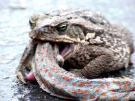Invaded by Toads

 Fear, was mentioned in my last post, well I am terrified of Amphibians especially snakes, toads, and frogs.
Fear, was mentioned in my last post, well I am terrified of Amphibians especially snakes, toads, and frogs. This morning my daughter and I are facing and fighting a family of Marine Toads that have invaded our patio. We have screamed, had the shovel, taken breaks, cried, and our strategy has been repeatedly unsuccessful so far. Needless to say, I am beside myself!
The marine toad is usually about 5 inches long and weighs about 3 pounds. The color of this animal is a brownish-red color. The marine toad makes a croaking sound to attract mates. The marine toad protects itself by blowing up so the predator can't swallow it.
"True toads (family Bufonidae) have dry, warty skin and parotoid glands behind the eyes. These glands release toxins to dissuade predators. Only the Marine Toad is large enough to release enough toxin to make a dog, cat, or person seriously or deathly ill.
The Giant Toad (a.k.a. Marine Toad or Cane Toad) is the largest of the frogs and toads found in Florida. The giant toad is not native to theUnited States. It was originally released in the U.S. in sugar cane fields to help control rats and mice. It now is commonly found in South Florida yards. The giant toad breeds year-round in standing water, streams, canals and ditches. Its call is a low-pitched trill and a chorus that sounds like an idling diesel engine. CAUTION: When this non-native species is threatened or handled, it secretes a highly toxic milky substance from its large parotoid glands at the back of its head, behind the ears. This secretion can burn your eyes, may irritate your skin, and can kill cats and dogs if they ingest the secretion.Symptoms of giant toad poisoning in pets include drooling, head-shaking, crying, loss of coordination, and, in more serious cases, convulsions. The dog's (or cat's) gums often turn red, an indicator used by veterinarians to distinguish toad poisoning from epilepsy. For this reason, pet owners should be familiar with their pet's normal gum color. Treatment: If you suspect toad poisoning, get a hose and run water in the side of the dog's/cat's mouth, pointing the animal's head downward so water isn't swallowed. Rub the gums and mouth to remove the toxin. This treatment is usually successful, but call your veterinarian immediately."
If I were not so fearful, I would cut them up with the shovel however; my heart cannot with stand getting close to them. My daughter on the other hand cannot kill a fly. These toads keep releasing their toxic milky substance as we struggle to round up or encourage them to find a new home. The family is growing and Bella is going wild at the sliding glass door. We are in a dilemma. Any comments or suggestions?
Effective Feb 2006 All comments have been saved and hidden due to transferring to Haloscan 25 Comments






































<< Home